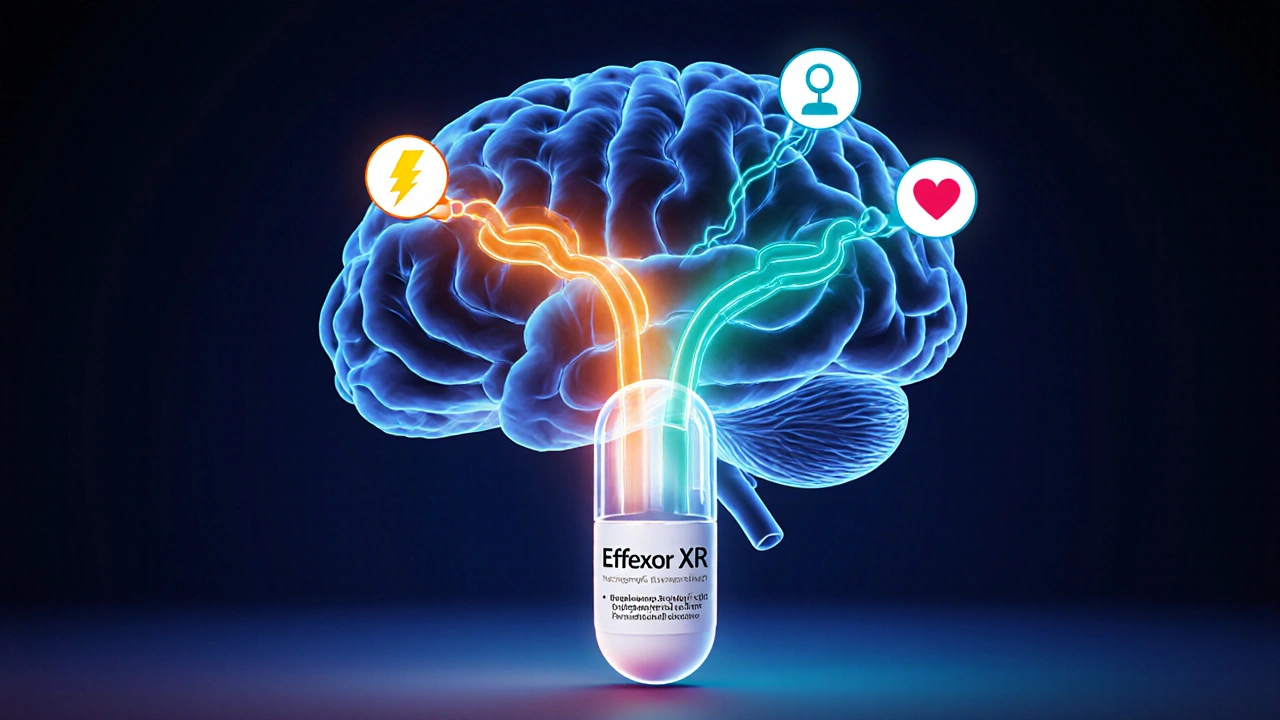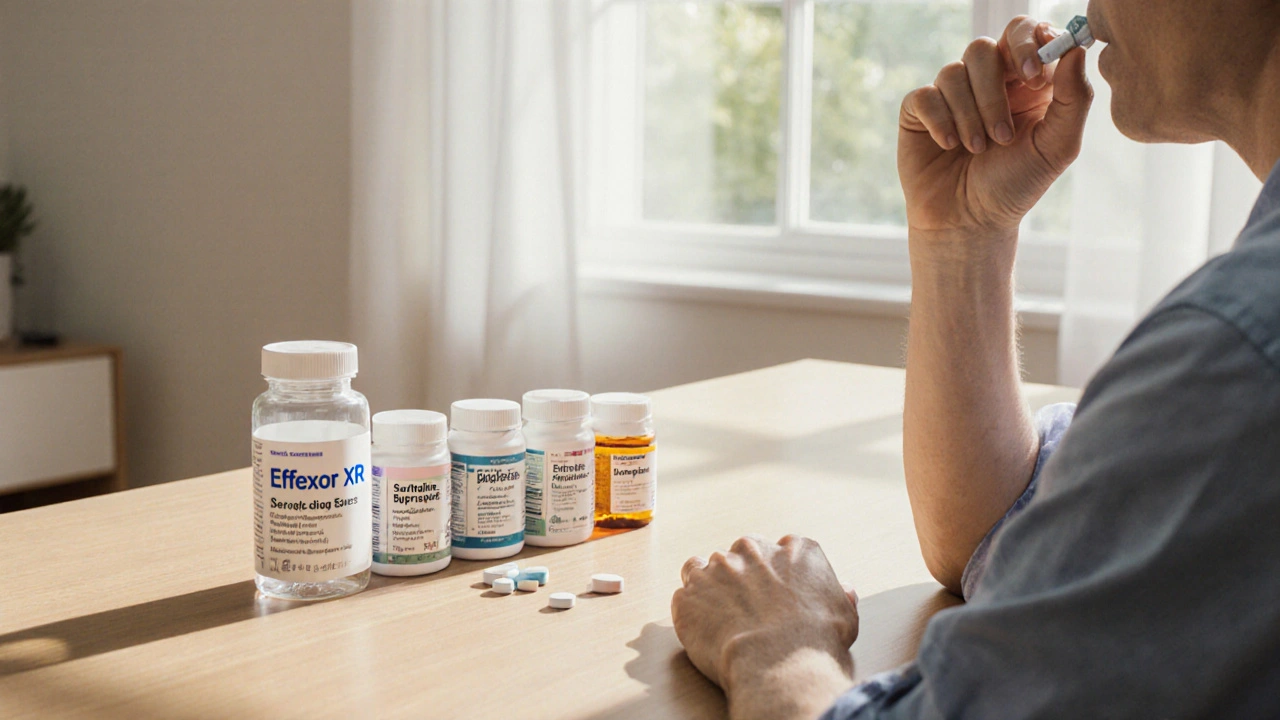Personalized Antidepressant Selector
Step 1: Primary Symptoms
Step 2: Priority Factors
Step 3: Your Situation
Your Best Options
Recommended Antidepressants
Trying to decide whether Effexor XR is the right fit for you or if another mood‑lifting pill might work better? This guide breaks down what makes Effexor XR (venlafaxine) unique, walks through the most common alternatives, and gives you a handy checklist so you can match a drug to your lifestyle, symptoms, and budget.
Quick Takeaways
- Effexor XR is an SNRI that works on both serotonin and norepinephrine, offering strong relief for major depression and generalized anxiety.
- Key alternatives include SSRIs (sertraline, escitalopram), another SNRI (duloxetine), and non‑SNRI options (bupropion, mirtazapine, vilazodone).
- Consider side‑effect profile, dosing frequency, weight impact, sexual side effects, and cost when choosing.
- For patients worried about sexual dysfunction, bupropion or mirtazapine are often gentler.
- Insurance coverage and generic availability usually make sertraline and duloxetine the most affordable choices.
What Is Effexor XR?
Effexor XR is a extended‑release formulation of venlafaxine, classified as a serotonin‑norepinephrine reuptake inhibitor (SNRI). It was first approved by the FDA in 1993 and quickly became a go‑to prescription for major depressive disorder (MDD), generalized anxiety disorder (GAD), and social anxiety disorder.
How Effexor XR Works
Effexor XR blocks the reuptake of two neurotransmitters-serotonin and norepinephrine-raising their levels in the brain. Higher serotonin helps stabilize mood and reduce anxiety, while increased norepinephrine can boost energy and improve concentration. This dual action often explains why some patients who don’t respond to a single‑target SSRI find relief with an SNRI.

When Doctors Prescribe It
Typical indications include:
- Major depressive disorder (moderate to severe)
- Generalized anxiety disorder
- Social anxiety disorder
- Panic disorder (off‑label in some regions)
Most clinicians start patients on 37.5mg daily for the first week, then increase to 75mg. The extended‑release tablet can be taken once daily, which improves adherence compared with the immediate‑release version that requires twice‑daily dosing.
Common Side Effects and Warnings
While many tolerate Effexor XR well, the drug is known for a few patterns worth noting:
- Dry mouth, nausea, and dizziness - usually subside after the first two weeks.
- Increased blood pressure - especially at doses above 150mg; regular monitoring is advised.
- Sexual dysfunction - decreased libido and delayed orgasm are reported by up to 30% of users.
- Discontinuation syndrome - abrupt stop can cause flu‑like symptoms, electric‑shock sensations, and agitation. A taper plan is essential.
Alternative Antidepressants to Consider
Below are the most frequently suggested alternatives, each with its own drug class and side‑effect fingerprint.
Sertraline (Zoloft) is a selective serotonin reuptake inhibitor (SSRI) that targets serotonin only. It’s widely prescribed for depression, anxiety, PTSD, and obsessive‑compulsive disorder.
Duloxetine (Cymbalta) is another SNRI, but with a slightly longer half‑life and stronger norepinephrine impact, making it a popular choice for chronic pain as well as mood disorders.
Escitalopram (Lexapro) is an SSRI known for a relatively clean side‑effect profile and once‑daily dosing, frequently used for depression and generalized anxiety.
Bupropion (Wellbutrin) belongs to the norepinephrine‑dopamine reuptake inhibitor (NDRI) class. It’s valued for low sexual side effects and modest weight‑loss potential.
Mirtazapine (Remeron) is a noradrenergic and specific serotonergic antidepressant (NaSSA) that often causes sedation and appetite increase, which can be useful for patients with insomnia or weight loss.
Vilazodone (Viibryd) combines SSRI activity with a partial 5‑HT1A agonist effect, aiming for antidepressant efficacy with fewer sexual side effects, though cost can be higher.
Head‑to‑Head Comparison Table
| Drug | Class | FDA‑Approved Uses | Typical Daily Dose | Half‑Life | Key Side Effects | Sexual Impact | Cost (UK, generic) |
|---|---|---|---|---|---|---|---|
| Effexor XR | SNRI | Depression, GAD, Social Anxiety | 75‑225mg | 5h (extended‑release) | Nausea, ↑BP, Dizziness | Moderate ↓ libido | £0.20‑£0.30 per tablet |
| Sertraline | SSRI | Depression, Anxiety, PTSD, OCD | 50‑200mg | 26h | GI upset, insomnia | High ↓ libido | £0.10‑£0.15 per tablet |
| Duloxetine | SNRI | Depression, Neuropathic Pain, Fibromyalgia | 30‑120mg | 12h | Dry mouth, ↑ BP, Liver enzymes | Moderate ↓ libido | £0.25‑£0.35 per tablet |
| Escitalopram | SSRI | Depression, GAD | 10‑20mg | 27‑32h | Headache, nausea | Moderate ↓ libido | £0.08‑£0.12 per tablet |
| Bupropion | NDRI | Depression, Smoking cessation | 150‑300mg | 21h | Insomnia, dry mouth | Low impact | £0.15‑£0.22 per tablet |
| Mirtazapine | NaSSA | Depression, Insomnia | 15‑45mg | 30‑40h | Weight gain, sedation | Low ↓ libido | £0.12‑£0.18 per tablet |
| Vilazodone | SSRI/5‑HT1A partial agonist | Depression | 20‑40mg | 25h | Diarrhea, nausea | Low ↓ libido | £0.40‑£0.50 per tablet |

Choosing the Right Pill: Decision Checklist
- Primary symptom focus. If low energy and concentration are major issues, an SNRI like Effexor XR or Duloxetine may edge out an SSRI.
- Sexual health. For patients who prioritize minimal sexual side effects, Bupropion, Mirtazapine, or Vilazodone are logical first steps.
- Weight considerations. If weight gain is a concern, avoid Mirtazapine; choose Sertraline, Escitalopram, or Bupropion.
- Blood pressure monitoring. High baseline BP makes Effexor XR and Duloxetine less attractive unless closely watched.
- Cost & insurance. Generic SSRIs (Sertraline, Escitalopram) and generic Bupropion are typically cheapest in the UK.
- Co‑existing pain. Duloxetine’s dual indication for neuropathic pain can simplify treatment for patients with chronic aches.
- Taper tolerance. If you’ve struggled with discontinuation, a longer‑acting drug like Escitalopram or Mirtazapine may give an easier taper.
Potential Pitfalls and How to Avoid Them
Switching between antidepressants can feel like a roller coaster if you ignore a few safety steps:
- Cross‑taper correctly. When moving from an SNRI to an SSRI, overlap for at least one week at reduced doses to prevent withdrawal.
- Watch for drug‑drug interactions. MAO‑inhibitors, certain anti‑arrhythmics, and St John’s Wort can raise serotonin levels dangerously.
- Schedule follow‑ups. Blood pressure checks for Effexor XR and liver function for Duloxetine should be done after 4-6 weeks.
- Set realistic expectations. Most antidepressants need 4-6 weeks of steady dosing before mood improvements become noticeable.
Frequently Asked Questions
Is Effexor XR stronger than sertraline?
Strength is hard to compare directly because they hit different neurotransmitters. Effexor XR’s dual action often helps patients who don’t respond to a pure SSRI like sertraline, but it also brings a higher risk of blood‑pressure rise.
Can I switch from Effexor XR to duloxetine without a washout?
Because both are SNRIs, many clinicians use a short cross‑taper: halve the Effexor XR dose while starting duloxetine at 30mg, then increase duloxetine after a week.
Which alternative has the fewest sexual side effects?
Bupropion is the standout for low sexual impact. Mirtazapine and vilazodone also score well, while most SSRIs and SNRIs can cause noticeable libido drops.
Do I need regular blood‑pressure checks on Effexor XR?
Yes. For doses above 150mg, check systolic and diastolic pressures every 4‑6 weeks. If you have a pre‑existing hypertension, discuss alternative options with your prescriber.
Is generic Effexor XR available in the UK?
A generic version of venlafaxine XR is on the NHS formulary, making it affordable for most patients. Brand‑name versions can be considerably pricier.
Can I take Effexor XR while pregnant?
Pregnancy safety is classified as Category C in the UK, meaning risks and benefits must be weighed. Many clinicians prefer an SSRI like sertraline during pregnancy due to a longer safety record.
What should I do if I miss a dose?
Take the missed tablet as soon as you remember if it’s within 12 hours. If it’s later in the day, skip it and resume the normal schedule - don’t double up.
Next Steps
Take the checklist above, compare the table, and talk to your GP or psychiatrist about which profile matches your priorities. If side‑effects are a deal‑breaker, ask about a trial period with a low‑dose alternative before committing to a full prescription. Remember, the right antidepressant is the one that fits your life, not just the label on the bottle.






11 Comments
Annie Thompson
October 12, 2025 AT 04:40 AMI have been wrestling with depression for years and the comparison chart finally gave me something concrete to cling to.
I the way the author laid out the side effect profiles feels like a map in a foggy landscape.
When I read about Effexor XR’s blood pressure concerns I remembered my own spikes during stressful weeks.
It was a relief to see duloxetine presented as an alternative that also tackles chronic pain.
The table of costs reminded me of the endless conversations with my pharmacist about generic availability.
I appreciate the note about discontinuation syndrome because I once stopped a medication cold turkey and felt like I was electrified.
The checklist at the end feels almost like a therapist’s worksheet that I can fill out on a rainy Sunday.
My partner noticed that I was more attentive after I switched from sertraline to bupropion following the sexual side effect warnings.
The mention of mirtazapine’s appetite increase made me think of my own weight loss struggles.
I was surprised that vilazodone, despite its high price, is praised for low libido impact.
The article’s tone is balanced yet it still carries a subtle bias toward newer branded drugs which I find a bit concerning.
I wish there were more patient stories woven into the data so readers could feel less alone.
The suggestion to monitor blood pressure every few weeks feels practical for anyone on an SNRI.
I also liked the reminder that tapering should be gradual because my doctor’s abrupt cuts left me shaking for days.
Overall the guide feels like a toolbox rather than a prescription and that empowers me to have a real conversation with my psychiatrist.
Parth Gohil
October 12, 2025 AT 07:26 AMHey, that’s a solid personal take – the pharmacodynamic nuances you mentioned really matter when you’re weighing SNRI versus SSRI options.
Effexor XR’s dual reuptake inhibition is often a double‑edged sword, boosting both mood and norepinephrine‑driven energy but also raising cardiovascular vigilance.
The cost‑effectiveness matrix you highlighted aligns with health‑economics data showing generic sertraline as a dominant strategy in low‑resource settings.
Also, the tapering protocol you quoted mirrors the consensus guidelines from the APA, which recommend a 25% dose reduction every one to two weeks for SNRIs.
Overall, your checklist is a pragmatic decision‑aid for clinicians and patients alike.
VAISHAKH Chandran
October 12, 2025 AT 10:13 AMWhile your enthusiasm for pharmacology is noted it borders on elitist jargon that alienates everyday patients.
India’s healthcare landscape cannot afford the luxury of endless tables and cost analyses.
One must prioritize accessibility over academic excess.
Pat Merrill
October 12, 2025 AT 13:00 PMWow, another “groundbreaking” guide, just what the world needed.
Vicki Roth
October 12, 2025 AT 15:46 PMI get the sarcasm but actually the piece does a decent job summarizing the main trade‑offs, especially for someone trying to navigate insurance formularies without a medical degree.
Vishal Bhosale
October 12, 2025 AT 18:33 PMThe article is fine but it could use a sharper focus – less fluff and more straight‑to‑the‑point comparison of efficacy percentages and side‑effect incidence rates.
Garima Gauttam
October 12, 2025 AT 21:20 PMSure, but why omit the real‑world adherence data? That’s the missing piece.
Georgia Nightingale
October 13, 2025 AT 00:06 AMThis guide reads like a melodramatic script – the author builds up each drug like a character in a tragedy, only to drop a cheap plot twist about cost at the end.
It’s entertaining, sure, but the drama distracts from the clinical utility.
When you look at the head‑to‑head table you see the hard facts: duloxetine and sertraline dominate the cost‑efficacy space, while mirtazapine shines for insomnia.
The emphasis on sexual side effects is valid, yet the narrative glosses over the importance of patient preference in shared decision‑making.
In short, the piece offers a theatrical overview but could serve clinicians better with a streamlined algorithm.
Chris Kivel
October 13, 2025 AT 02:53 AMAppreciate the colorful description; the practical takeaways about monitoring blood pressure and taper schedules are exactly what most of us need in everyday practice.
sonia sodano
October 13, 2025 AT 05:40 AMWhile the friendly tone is nice, it completely sidesteps the fact that many of these drugs have been overprescribed in the West, leading to a cascade of dependency issues.
Praveen Kumar BK
October 13, 2025 AT 08:26 AMReading this feels like an endorsement of pharmaceutical capitalism without acknowledging the moral responsibility of clinicians to avoid unnecessary polypharmacy.
The author should have highlighted non‑pharmacologic interventions as first‑line options before diving into a list of chemical compounds.
Moreover, the disclaimer about discussing choices with a doctor is insufficient when the data presented is skewed toward profit‑driven medications.
Patients deserve transparent risk‑benefit analyses that prioritize safety over market share.
In the end, the guide is a reminder that medical advice often lives at the intersection of science and industry.